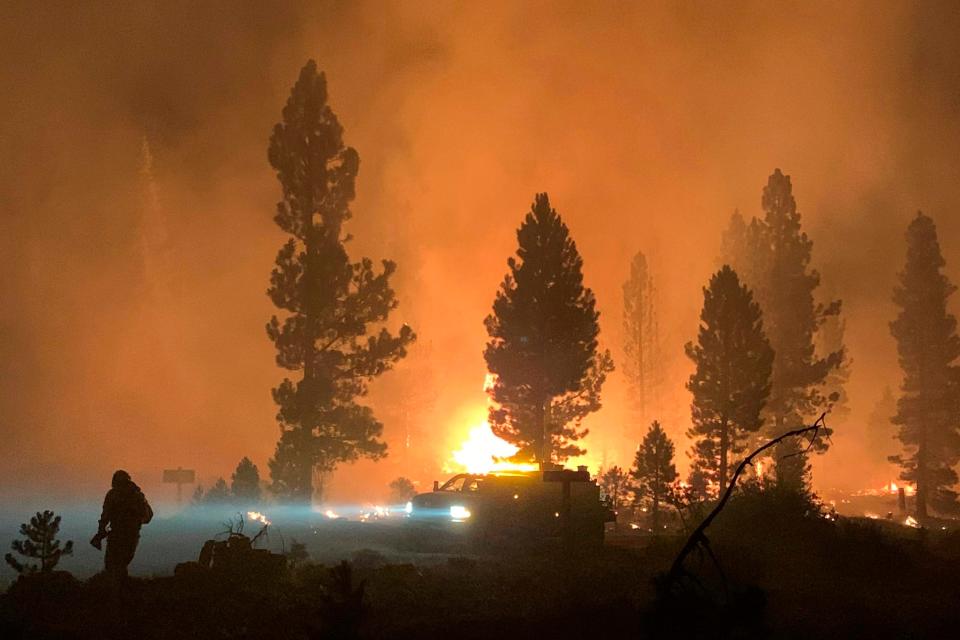Massive Bootleg Fire burns in Oregon as officials seek outside help
A massive wildfire in Oregon that's grown to about half the size of Rhode Island has prompted fire officials to call for help from outside the Pacific Northwest to prepare for additional blazes across the parched state.
The Bootleg Fire, now some 606 square miles in size, is burning 300 miles southeast of Portland in and around the Fremont-Winema National Forest, a vast expanse of old-growth forest, lakes and wildlife refuges. Fortunately, the fire is located in a remote area away from population masses.
The worry is dry conditions, a drought and the recent record-breaking heat wave in the region have created tinderbox conditions, so resources such as fire engines are being recruited from places including Arkansas, Nevada and Alaska.
At least 2,000 homes have been evacuated at some point during the fire and another 5,000 are threatened. At least 70 homes and more than 100 outbuildings have gone up in flames.

The forecast for the next few days was ominous: "The combination of extreme drought, gusty winds, and thunderstorms will produce fire weather concerns for the northern Great Basin and northern Rockies through Thursday," the National Weather Service said.
"Thunderstorms ahead of an advancing cold front entering the Pacific Northwest today are likely to produce little rainfall, but lightning could reach the dehydrated terrain and spark new wildfires," the weather service said. "Red flag warnings are in effect and stretch from northern California to Wyoming."
A red flag warning means critical fire weather conditions are either occurring or will shortly.
What is a heat dome?: Heat dome brings record-breaking high temperatures to the West, exacerbating drought and wildfires
In all, 83 large wildfires are burning across 13 states, most of them in the western U.S., the National Interagency Fire Center said Tuesday. Almost 20,000 firefighters were battling the blazes, which encompass nearly 1.3 million acres of land.
Sixteen large, uncontained fires burned in Oregon and Washington state alone . On Tuesday, officials temporarily closed all recreational and public access to state-managed lands in eastern Washington due to fire danger, starting Friday.
Further south, in north-central California, the 95-square-mile Dixie Fire burned on Tuesday, threatening more than 800 homes and other structures, Cal Fire said. The fire, which is only 15% contained, expanded in size overnight, and it's still moving to the north and east.
Monday, the fire generated a thunderstorm over itself, hurling lightning bolts and whipping up gusty winds.
The fire's edge is a few miles from the town of Paradise, California, which burned almost to the ground three years ago in a wildfire that k4illed 85 people.
Smoke from wildfires has resulted in air quality issues as far east as portions of the Upper Midwest and even the Northeast, the National Weather Service said.
Wildfires aren't just a West Coast climate problem. Smoky skies surrounding the Statue of Liberty creating unhealthy air quality as smoke gets transported 1000s of miles east. pic.twitter.com/yZ9GeqsBNH
— Drew Tuma (@DrewTumaABC7) July 20, 2021
"We've got an area of high pressure sitting over the Rockies and it's pretty large," Kacie Hoover, a NWS meteorologist, told the Indianapolis Star. "So it's just the way the airflow is going from the Pacific Northwest into Western Canada and then all of that air is being brought down into the Midwest, which is why we're seeing the smoke above us."
Indianapolis residents woke up Tuesday to a red morning sun and hazier skies because of the smoke in the upper atmosphere. Residents can look up and see the fires' impacts as the pattern continues, Hoover said, and might even see some prettier sunsets.
Indiana wasn't the only state shrouded in smoke: the entire state of New York was under an air quality advisory until Wednesday. The AQI reading in New York City Tuesday evening was 157, considered unhealthy.
The smoke from the Canadian wildfires is making its way down the east coast, and it made for a very hazy sunrise in #Pittsburgh today. When the sun was finally visible through the haze it passed right behind the Cathedral of Learning, making for an eerie, post-apocalyptic scene. pic.twitter.com/AYpPutm7CU
— Dave DiCello (@DaveDiCello) July 19, 2021
The Environmental Protection Agency recommends that people take it easy when the air quality is unhealthy, reduce physical activity outside, and set the air conditioner to "recirculate." Prolonged exposure can lead to headaches, sore throats and worse, according to the Centers for Disease Control and Prevention, which also recommends sheltering at home when the air quality gets bad.
But hazy skies won't be in the forecast for the East Coast for long. A cold front will move into the Northeast from Canada Wednesday, clearing out some smoke in the process, Accuweather said.
Contributing: Elinor Aspegren, USA TODAY; Rashika Jaipuriar, Indianapolis Star; The Associated Press
This article originally appeared on USA TODAY: Bootleg Fire: Oregon wildfire burns; Dixie Fire ongoing in California

